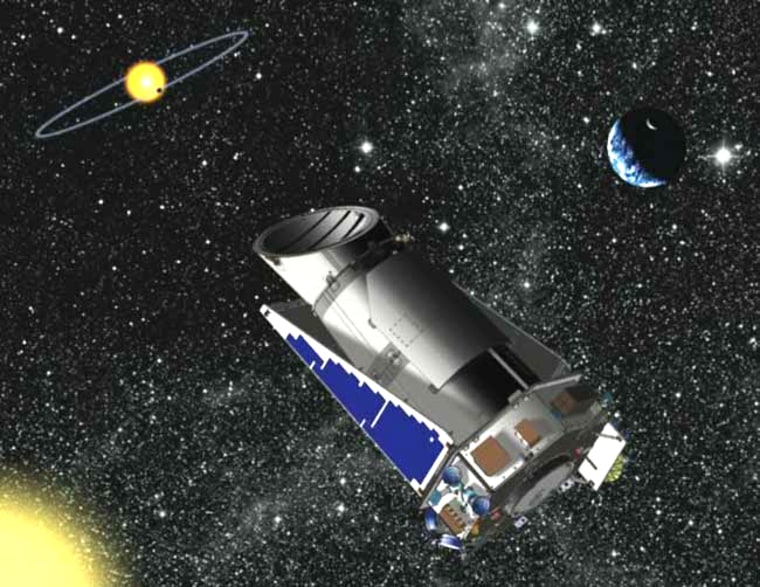After weeks of trying, NASA said Thursday it is calling off further efforts to restore the crippled Kepler space telescope's full planet-hunting capability — but now it's looking at alternate tasks it could take on, including a different way to find alien worlds.
Meanwhile, the $600 million mission's scientists are continuing to analyze the years' worth of data already collected by the probe. Kepler's principal investigator, Bill Borucki of NASA's Ames Research Center, said the analysis could identify an Earth-size planet in an Earthlike orbit around a sunlike star within the next three years. And he bristled at a reporter's suggestion that the spacecraft's problems meant the mission was over.
"It is not the end of the Kepler mission," Borucki said during a teleconference to announce the end of revival efforts. "That is a terrible misstatement."
What's over is Kepler's capability to stare fixedly at a patch of sky and monitor 150,000 stars for the faint dip in light as a planet passes over a stellar disk. That strategy for finding other worlds, known as the transit method, has produced more than 3,500 planet candidates and 135 confirmed planets so far.
Some of those planets are even smaller than Earth, and some of them are on the edge of their stars' habitable zones. The mission has already led scientists to conclude that planets should be abundant in the Milky Way, with smaller planets outnumbering larger ones. In fact, the figures suggest that there should be 60 billion potential habitable planets in our galaxy alone.
"We know that our galaxy is filled to the brim with planets," Borucki said.
However, the failure of Kepler's fine-pointing navigation system, four years after launch, means scientists will have to sift through the data collected so far even more carefully than they expected, to make absolutely sure about the detections they report. "We're going to have to work hard for the next couple of years," Borucki said.
What went wrong
The navigation system relied on four gyroscopic reaction wheels to keep the spacecraft steady enough to make its high-resolution observations of stars in a patch straddling the constellations Cygnus and Lyra. One of the wheels seized up last year, and the other one stopped in May. With only two wheels, Kepler's fine-pointing system could no longer operate.
For weeks, Kepler's handlers at NASA's Jet Propulsion Laboratory tried to get the two faulty wheels working again. Charles Sobeck, the mission's deputy project manager, said part of the strategy involved turning the wheels backward — much like what you might do if a wheel on your shopping cart got stuck.
One of the wheels did start working again, Sobeck said, but only for a few hours. Late last week, the engineers decided to give up. "We were doing what we thought was due diligence ... We had very little hope that it was actually going to be recoverable," Sobeck told NBC News.
What lies ahead
Now Kepler has been put back into rest mode to conserve its thruster fuel while the mission managers discuss what to do with the spacecraft. Even though the fine-pointing capability can't be restored, Kepler could take on other tasks. NASA has already begun soliciting mission proposals, which so far include studying supernovas, looking for asteroids, and making microlensing observations.
Microlensing involves observing how light from a distant object is bent by the gravitational influence of a closer object that passes right in front of it. Such observations have been used to detect the presence of more than a dozen extrasolar planets — and Kepler could conceivably get back into the planet-hunting business via that route.
However, Paul Hertz, the director of the Astrophysics Division at NASA Headquarters, said any proposed revision in Kepler's mission would have to be judged competitively against other space science opportunities early next year. For now, Kepler is working with the $18 million that's been budgeted for science operations in the current fiscal year, Hertz said.
NASA might pull the plug on the Kepler spacecraft next year if its continued operation for a retooled mission doesn't rank high enough among the space agency's funding priorities. But in any case, Kepler's scientists back on Earth will keep looking for alien worlds in the data that's come down to date. And there'll be more planet-hunting missions ahead — including the Transiting Exoplanet Survey Satellite, or TESS, scheduled for launch in 2017.
"Kepler has made extraordinary discoveries in finding exoplanets, including several super-Earths in the habitable zone," John Grunsfeld, associate administrator for NASA's Science Mission Directorate, said in a statement paying tribute to the spacecraft. "Knowing that Kepler has successfully collected all the data from its prime mission, I am confident that more amazing discoveries are on the horizon."
More about the planet search:
- Scientists respond to Kepler's plight with poetry
- Flash interactive: How alien worlds are found
- NBC News archive on the Kepler mission
Alan Boyle is NBCNews.com's science editor. Connect with the Cosmic Log community by "liking" the NBC News Science Facebook page, following @b0yle on Twitter and adding +Alan Boyle to your Google+ circles. To keep up with NBCNews.com's stories about science and space, sign up for the Tech & Science newsletter, delivered to your email in-box every weekday. You can also check out "The Case for Pluto," my book about the controversial dwarf planet and the search for new worlds.
